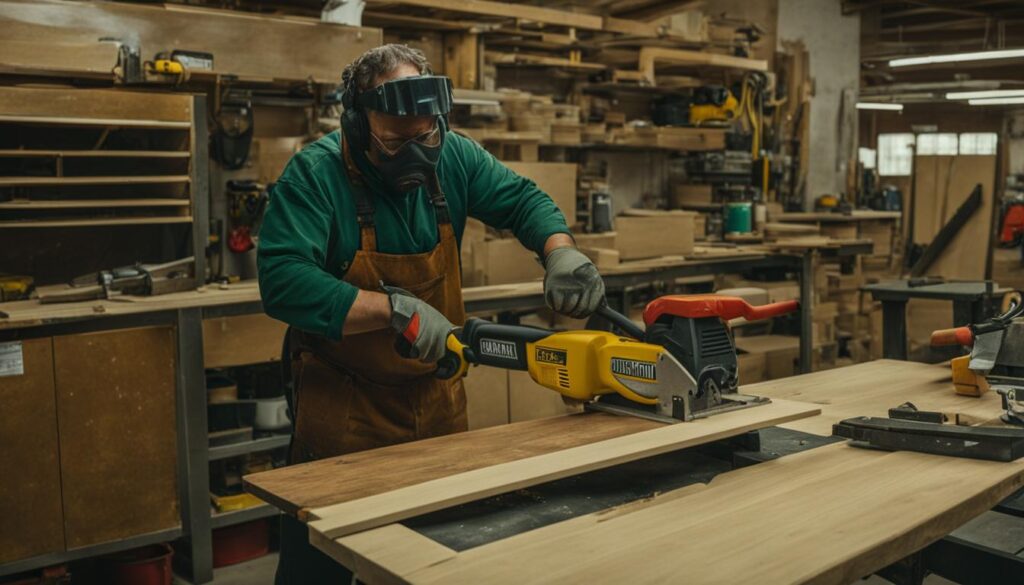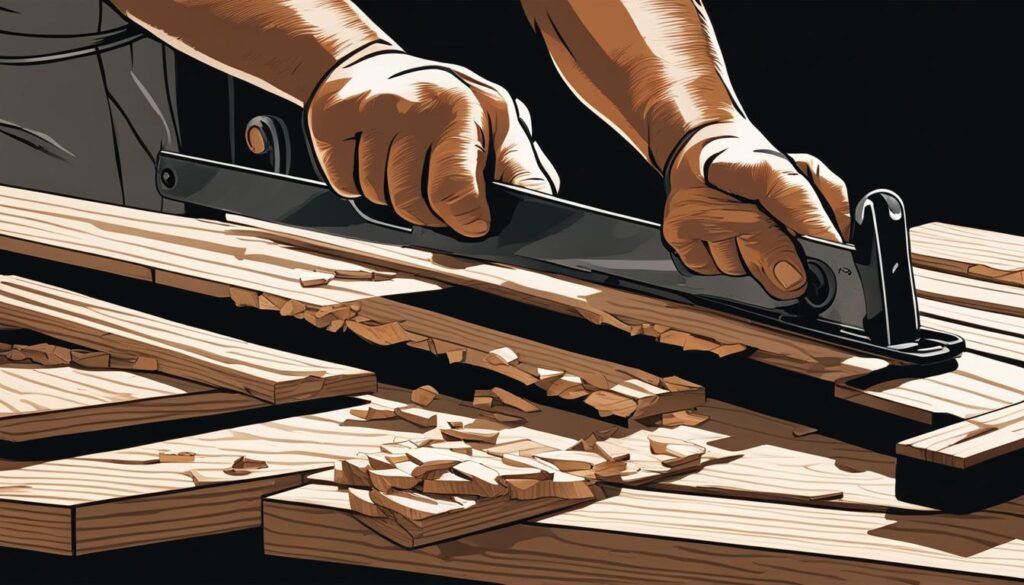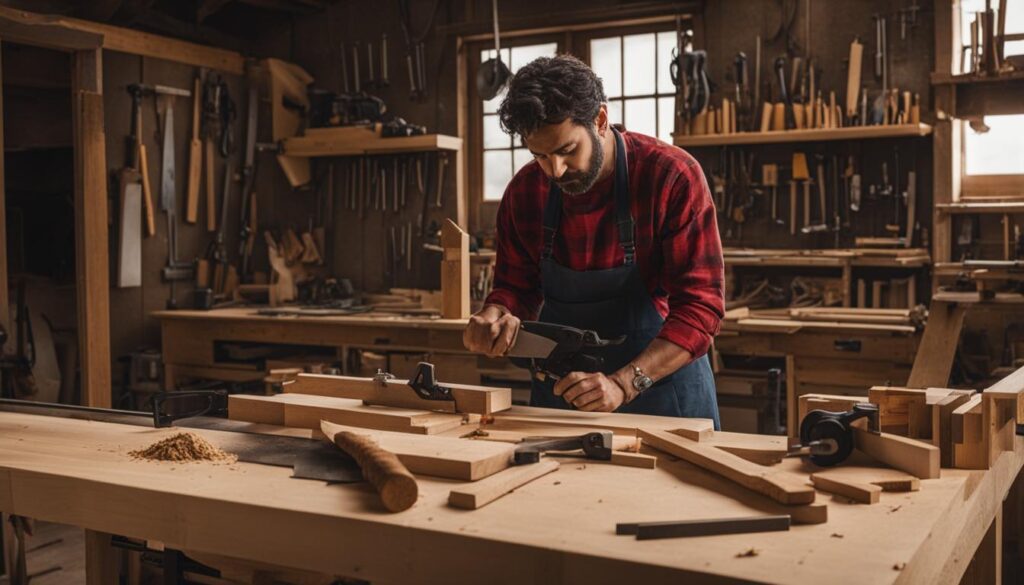We may earn money or products from the companies mentioned in this post.
Woodworking is a fun and rewarding hobby, but it also comes with risks. From sharp tools to flying debris, it’s essential to protect yourself while working in your woodworking workshop. By wearing the right gear, you can minimize the risk of accidents and injuries without compromising on the quality of your work.
In this article, we will cover the essential woodworking safety gear that every craftsman needs to have in their workshop. Whether you’re a beginner or an experienced woodworker, these safety tips can help you enjoy your hobby safely and efficiently.
Key Takeaways
- Protective eyewear and safety gloves are essential for preventing eye injuries and cuts while working with wood.
- Ear protection and dust masks help reduce the risk of hearing damage and respiratory problems in the long term.
- Safety boots, respirators, and safety aprons can provide extra protection against heavy objects, harmful fumes, and flying debris.
- Don’t forget to consider additional safety gear like safety goggles and protective helmets for added protection for your head and eyes.
- Investing in the right safety gear ensures a safer working environment and allows you to concentrate fully on your work without worrying about accidents or injuries.
Protective Eyewear and Safety Gloves
Woodworking can be a hazardous activity, with sharp tools and flying debris posing a risk to your eyes and hands. Protective eyewear and safety gloves are crucial safety gear that every woodworker should have.
Protective Eyewear: When working with wood, it’s essential to wear safety glasses or goggles to protect your eyes from dust, wood chips, and other debris that could potentially cause eye damage. Look for eyewear with impact-resistant lenses that wrap around the sides of your eyes to provide complete protection.
Safety Gloves: Your hands are also at risk during woodworking, making it essential to invest in safety gloves that provide adequate protection. Choose gloves that fit correctly and are made from durable materials that can withstand sharp tools and rough surfaces. Leather, Kevlar, and other synthetic materials are commonly used in safety gloves for woodworking.
| Types of Protective Eyewear: | Features: |
|---|---|
| Safety Glasses | Impact-resistant lenses, wraparound design for full eye protection. |
| Safety Goggles | Seal around the eyes, providing complete protection from flying debris and dust. |
- Choose eyewear with an ANSI (American National Standards Institute) rating.
- Make sure your eyewear fits correctly and doesn’t impede your vision.
Similarly, safety gloves come in various types:
| Type of Safety Gloves: | Features: |
|---|---|
| Leather Gloves | Durable, comfortable, provide good grip for holding tools. |
| Kevlar Gloves | Provide excellent cut resistance, durable, and protect against punctures. |
| Latex Gloves | Disposable, provide adequate protection against dirt and dust. |
- Choose gloves that fit correctly and allow for good dexterity.
- Always wear gloves when operating power tools or handling rough materials.
In conclusion, proper protective eyewear and safety gloves are necessary when working with wood. Investing in good quality eyewear and gloves is an investment in your safety. By taking the necessary precautions, you can ensure that your woodworking projects are completed safely and efficiently.
Ear Protection and Dust Masks
As mentioned in the previous section, woodworking generates a significant amount of noise and dust that can be harmful to your health. That’s why ear protection and dust masks are essential safety gear for every craftsman.
Ear protection comes in different forms, including earmuffs and earplugs. They work by reducing the amount of noise that reaches your eardrums, protecting you from hearing damage. If you work in a particularly noisy environment, earmuffs are the best option as they offer more noise reduction than earplugs. However, earplugs are more practical and comfortable to wear for extended periods.
Dust masks or respirators are necessary when working with wood to protect your respiratory system from harmful sawdust and other fine particles. A dust mask prevents you from inhaling these particles, which can lead to respiratory issues over time. A respirator offers enhanced protection against fumes and chemicals that may be present in woodworking processes such as staining or finishing.
| Type of Ear Protection | Pros | Cons |
|---|---|---|
| Earmuffs | More noise reduction, suitable for noisy environments | Less practical and less comfortable to wear for extended periods |
| Earplugs | More practical and comfortable to wear for extended periods | Offer less noise reduction than earmuffs |
When it comes to dust masks, there are two main types: disposable and reusable. Disposable dust masks are inexpensive, lightweight, and easy to use. However, they need to be replaced regularly and may not provide enough protection against certain dust particles. Reusable respirators, on the other hand, are more expensive but offer better protection and are more environmentally friendly over time.
Always wear protective gear for your ears and respiratory system when working with wood. It may seem unnecessary, but it’s the best way to protect your health and avoid long-term damage.
- Use earmuffs or earplugs to protect your ears from harmful noise levels.
- Use a dust mask or respirator to protect your lungs from sawdust and other fine particles.
- Consider investing in a reusable respirator for better protection and reduced environmental impact.
Safety Boots, Respirators, and Safety Aprons
Woodworking is an activity that involves many risks, and it’s crucial to ensure that you wear the right safety gear. In this section, we’ll explore additional safety gear that every woodworker should consider adding to their workshop: safety boots, respirators, and safety aprons.
Safety Boots
When working with heavy machinery or large pieces of wood, your feet can be at risk of accidental impacts or heavy objects falling on them. Safety boots provide extra protection for your feet, and they’re essential for any woodworker who wants to stay safe in their workshop. Steel-toed safety boots are a popular choice, as they provide the most protection against heavy objects.
Respirators
In some woodworking processes, there may be harmful fumes or chemicals present. Using a respirator helps to filter out these harmful substances and protects your respiratory system. Respirators are also useful when you’re working with wood that has been treated with chemicals or stains, or when you’re using paints or solvents.
Safety Aprons
A safety apron protects your body from wood chips, splinters, and other flying debris while you work. They’re particularly useful when you’re using power tools or working on a lathe, as these tools can generate a lot of debris. Safety aprons are typically made from heavy-duty materials such as leather or canvas and are designed to withstand sharp objects, flying debris, and spills.
Conclusion
Investing in woodworking safety gear is crucial for every craftsman. By prioritizing safety, you can minimize the risk of accidents and injuries while enjoying your work. Protective eyewear and safety gloves are essential for shielding your eyes and hands from flying wood chips and sharp tools. Ear protection and dust masks help reduce the risk of hearing damage and protect your respiratory system from harmful dust particles.
In addition to the aforementioned safety gear, safety boots, respirators, and safety aprons provide extra protection against heavy objects, harmful fumes, and flying debris. It’s also important to consider additional gear like safety goggles and protective helmets for added protection for your eyes and head.
Creating a safe working environment with the right woodworking safety gear ensures both your safety and the efficiency of your work. So, remember to equip yourself with the necessary safety gear and make it a priority in your woodworking workshop.
FAQ
What are the essential woodworking safety gear items for every craftsman?
The essential woodworking safety gear items that every craftsman should have are protective eyewear, safety gloves, ear protection, dust masks, safety boots, respirators, safety aprons, safety goggles, and protective helmets.
Why is it important to protect your eyes and hands in woodworking?
Protecting your eyes and hands is crucial in woodworking because it helps prevent injuries. Protective eyewear shields your eyes from flying wood chips, dust, and debris, while safety gloves offer protection against sharp tools, preventing cuts and abrasions.
How can ear protection and dust masks benefit woodworkers?
Ear protection, such as earmuffs or earplugs, helps reduce the risk of long-term hearing issues caused by loud noise levels in woodworking. Dust masks or respirators, on the other hand, filter out fine particles generated during woodworking, protecting your respiratory system from harm.
What additional safety gear should woodworkers consider?
In addition to the essential safety gear, woodworkers should also consider wearing safety boots for foot protection, respirators for enhanced respiratory protection, and safety aprons to shield the body from wood chips, splinters, and flying debris.
Why should woodworkers prioritize safety and invest in proper safety gear?
Prioritizing safety and investing in proper safety gear is crucial for woodworkers because it helps create a safer working environment. It minimizes the risk of accidents, injuries, and long-term health issues, allowing craftsman to enjoy woodworking with peace of mind.
Affiliate Disclosure: This post may contain affiliate links. If you purchase through our link, we may receive a small commission, but at no additional cost to you. For more information, please see our Disclosure statement.



